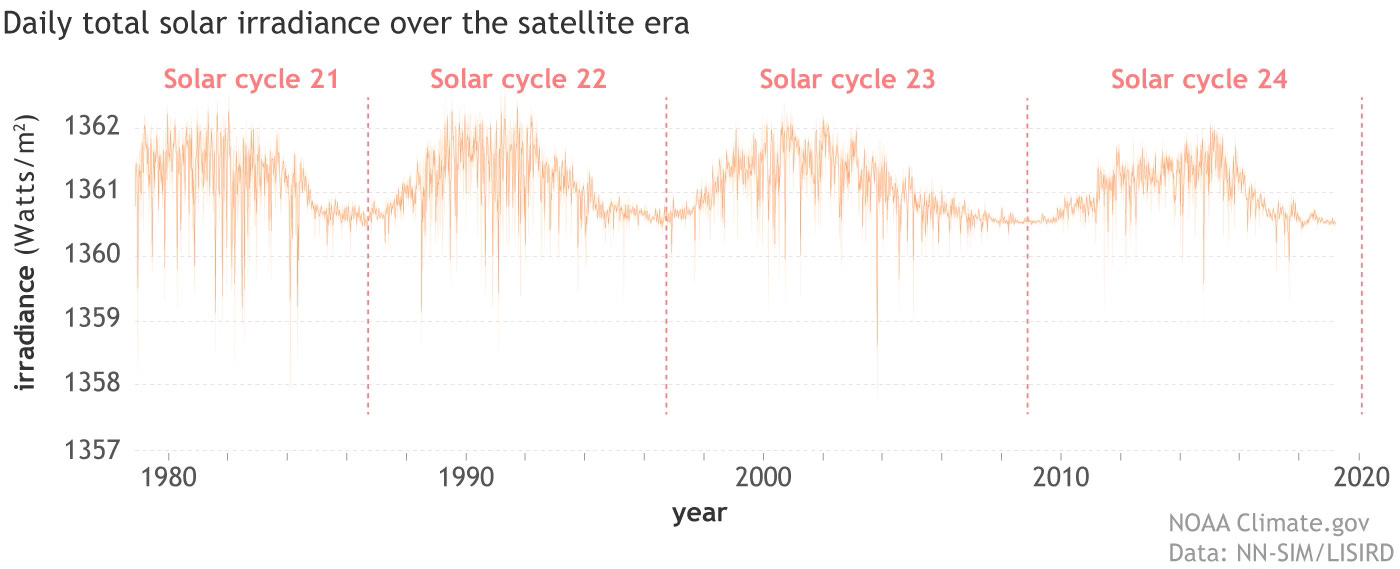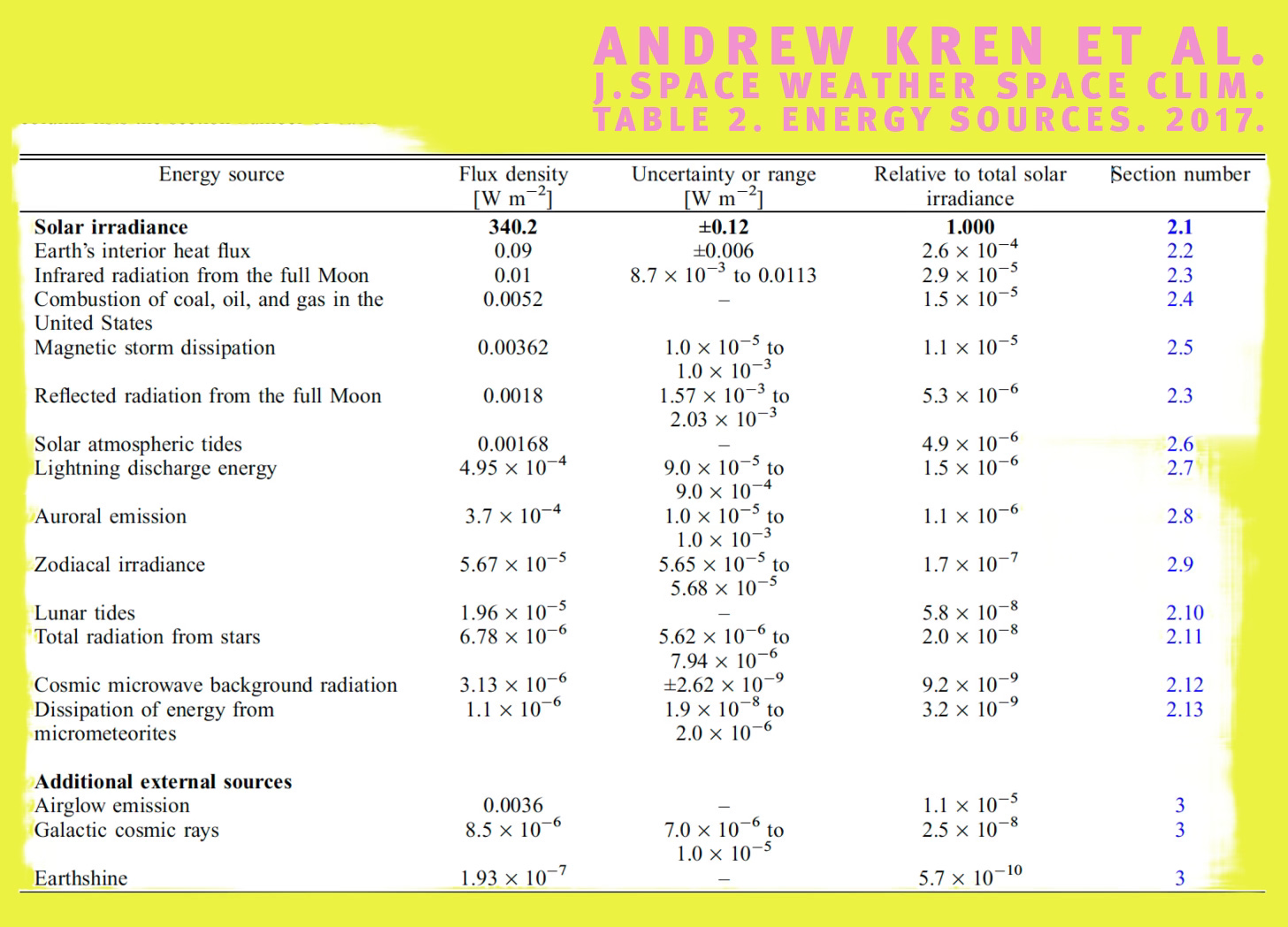In a world fixated on CO2 fluctuations, the Sun’s constant presence as Earth’s primary energy source is often overlooked. It is fundamental to climate resilience.
The Sun’s constant, predictable cycles—especially daily rotations, seasonal tilts, and longer-term orbital variations—have shaped our evolution. To be sure, Homo sapiens, and other life on Earth, has evolved to function within these variously nested and overlapping cycles with perhaps two rhythms: glacial and inter-glacial and transitioning interludes.
Perhaps even to maximise the energy provided by the Sun to these rhythms.
Life on Earth has evolved under these conditions that are ever changing but within predictable cycles. As the Sun always rises, I have a circadian rhythm, and the whales will soon be breaching in Keppel Bay across from where I live, as the birds have also migrated based on seasonal clues — to mention just two types of adaptation.
Every Friday, for six weeks, I promised to reveal another component of my Theory of Climate Resilience. I explained ‘evaporation and precipitation’ as the mechanism for preventing the tropical oceans from overheating, plank #1. A week later, I offered up plank #2 — ice as a cooling energy storage system, with masses of it in Antarctica. I moved on to gravitational effects, as an external driver, with plank #3 focused on a force I am calling the Moon’s Tidal Push. This is a subsurface wave across the Pacific Ocean that I hypothesis varies in amplitude and frequency driven primarily by changes in the moon’s declination cycle. Last Friday, I explained plank #4 that is about outgoing long-wave radiation (OLR), and how difficult it is to calculate once the hydrological cycle is taken into consideration.
Since then, I have received criticisms variously insisting that I clarify my estimate of climate sensitivity, which is jargon for how much the mean global temperature of Earth would rise given a doubling of atmospheric carbon dioxide levels. This is an obsession of mainstream climate science that falsely attributes climate change to a purported reduction in OLR. Meanwhile, I had thought I had clearly written that there is a need to consider tropical convection, even how that might increase, and how that will directly affect OLR and that such effects will be global and vary by latitude, thus I have formulated a Regional IR Feedback Hypothesis.
Furthermore, it is the case that if CO2 levels increase such that the lower troposphere warms, the air can expand upward, raising the tropopause height. I thank those who have suggested that I draw more attention to the atmosphere being an open system where warmer air expands and cools adiabatically, but this does not necessarily maintain ‘equilibrium’ as some go on to insist. For sure, the height of the troposphere varies even with the passage of the Moon overhead.
And it is the case that I have already published a value for Equilibrium Climate Sensitivity (ECS) of 0.6 degrees Celsius, that was back in 2017 in the journal GeoResJ (Volume 14, December 2017, Pages 36-46); that journal was subsequently closed while an unsuccessful campaign was mounted to have our paper retracted. In the end, my 2017 value was based on a method using AI and formulated independently of theory and somewhat as a rebuttal. Going forward I would like the opportunity to place such information anew into a coherent theory of climate resilience. This is a work in progress, and I thank you for your patience.
Today, the fifth Friday since I launched my Substack, I am revealing Plank #5 of my Theory of Climate Resilience that is the Sun’s Constancy: 99% Sun, 100% Life.
Solar irradiance is the dominant energy input to Earth. I am referring to the radiant flux from the Sun, measured as Total Solar Irradiance (TSI). The globally averaged TSI is often approximated to 340.2 W/m².
On the one hand I am loathed to accept an average value expressed as watts per metre squared when most of this energy is received at the equator in the middle of the day, but it is the convention, and this convention makes the Sun’s contribution to the atmosphere’s ever changing energy level comparable with other energy sources. Specifically, there is an important study by Andrew Kren and colleagues (J.Space Weather Space Climate, 2017) that lists 18 sources of energy including the Earth’s interior heat flux, combustion of coal, oil and gas, galactic cosmic rays, even lunar tides. The focus is on external sources of energy impacting the atmosphere. Earth's interior heat flux is listed as composed of thermal energy emitted from the Earth's interior and crust into the atmosphere and oceans. Sources internal to the atmosphere like convection and longwave radiation emission are not included though they will affect the distribution of energy, and the final energy level.
The study by Kren et al. (2017) building on the work of Sellers (1965, Physical Climatology, University of Chicago Press) emphasises that solar irradiance provides energy that is over 2,600 times larger than the sum of all other external energy sources combined.
So, the Sun contributes 99.95% of the energy to the Earth atmosphere! And through constant cycles of predictable length including daily, seasonal, and then there are sunspot cycles with effects on magnetism and in turn on cosmic ray flux.
The sunspot cycle is approximately 11 years, and it is part of a larger 22-year solar magnetic cycle. The 11-year cycle refers to the periodic increase and decrease in the number of sunspots, while the 22-year cycle accounts for the reversal of the Sun's magnetic polarity.
Solar magnetism is something additional to solar irradiance that will affect climate. A weaker magnetic field will result in more galactic cosmic rays entering the lower atmosphere in turn causing more cloudiness and cooling. The solar wind also varies with solar cycles and has been associated with changes in the North Atlantic Oscillation (NAO). The solar wind is not solar irradiance, and neither is solar magnetism. I plan to tease apart these issues and their impact on climate resilience in more detail as I develop my climate resilience theory further. Not in this article.
About 71% of incident solar radiation is absorbed by the Earth system, while the rest is reflected-back into space. The absorbed energy is redistributed or stored through processes including convection, latent heat, and infrared radiation.
Solar irradiance spans wavelengths from gamma rays to radio waves. UV radiation is a component of solar radiation that varies by up to 8% in predictable ways over the sunspot cycles affecting atmospheric chemistry and thus climate.
Incoming solar radiation powers Earth's atmosphere and oceans, affecting weather patterns, climate dynamics, and biological activity. Biological activity in turn affecting atmospheric levels of carbon dioxide, as I will explain in detail soon.
Today, I am simply listing solar irradiance as my plank #5. I am stating that it contributes 99.95% of the energy to the Earth atmosphere through nested cycles of predictable length including daily and seasonal cycles, and then there are sunspot cycles and beyond those, Earth’s orbital parameters because of cyclical changes in the Earth’s tilt, wobble and its orbital eccentricity with a periodicity of perhaps 100,000 years.
Solar irradiance refers to the power per unit area (measured in watts per square meter, W m⁻²) received from the Sun in the form of electromagnetic radiation, which includes ultraviolet (UV), visible light, infrared, and other wavelengths across the spectrum (e.g., gamma rays to radio waves). It does not include magnetism (e.g., the Sun’s magnetic field variations) or solar wind (streams of charged particles like protons and electrons), as these are distinct solar phenomena, not electromagnetic radiation.
It is necessary to consider the constancy of solar irradiance as an energy source and that it comes in cycles of varying length and magnitude, some nested and others overlapping, before jumping to conclusions about unprecedented human-caused climate change — because there is nothing new under the Sun.






The Sun is a practically steady driver of the earth's energy transport process. If it were more erratic or even predictably variable, it would be a convenient source of externally imposed perturbations of the earth's energy transport process, but it isn't such.
The Sun drives the earth's energy transport process so as to make it a dissipative process. The high quality (over five thousand degree Kelvin) energy in sunlight is degraded into lower quality energy in outgoing longwave radiation (OLR, around 255 degrees Kelvin). The quality incident energy is partly reflected or scattered away. The rest is absorbed by the earth's atmosphere and condensed matter surface. Over the billions of years, the system will have continually explored the myriad of possible ways it has for spreading the absorbed radiative energy back to the rest of the universe, which, as you may check by looking at them night sky, is not far from a black body. Its average temperature is about 2.7 degrees Kelvin, so that it acts as a mighty sink for the OLR.
The energy's dissipative passage through the system is complicated. The condensed-matter absorbed energy is cooled as it enters at temperatures around 288 degrees Kelvin, and passes as heat and by evaporation into the atmosphere at temperatures around 255 degrees Kelvin, whence it radiates easily to the 2.7 degrees Kelvin sink. Downgrading all the way. Exceptionally, it occasionally and transiently gets hotter, as in flashes of lightning, particularly in sporadic local transient positive feedback in thunder storms. The global stability of the dissipation indicates that negative feedback describes its overall character, as in a dynamical régime not too far from a globally nearly steady state.
The currently dominant Marxist–WEF–IPCC–warmista gang seductively and delusively proposes that somehow the passing energy participates in a mechanism of "global amplification through positive feedback through the radiative effect of water vapour". That mechanism isn't specific for CO2-level perturbations. It goes against the overall dissipative nature of the process. Nevertheless, using their seductive and delusive proposal, the gangsters have lured gullible Western politicians (with a very few honourable exceptions) into wrecking their nations' economies. Counter to that, Jennifer's proposal of an "equilibrium climate sensitivity" of 0.6 degrees Kelvin, to me, seems near enough, subject to powerful external driving, such as Milankovitch effects.